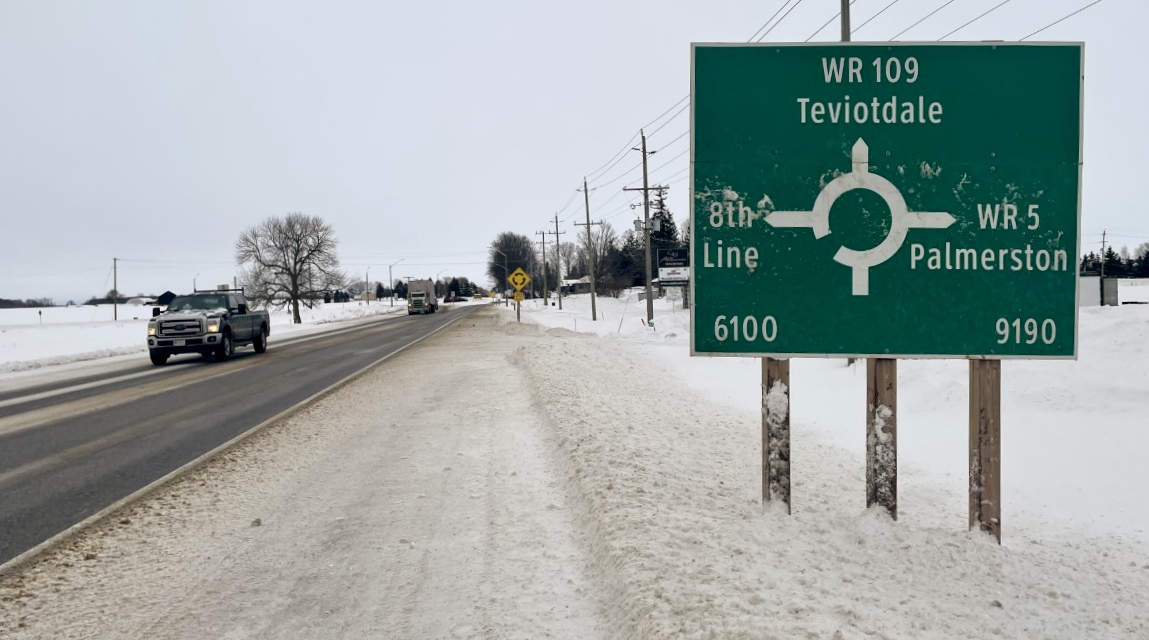WELLINGTON COUNTY – County council has accepted the final report on a new Roads Master Action Plan (Road MAP).
Roads committee chair councillor Andy Lennox told council on Jan. 27 that the final report, more than a year in development, was recommended for approval at a committee meeting on Jan. 10.
“This is a large undertaking, not only in the time spent and effort spent on this project, but this is really helping to set the direction in terms of our roads network for the next 20 years and the shorter term horizon in terms of investment – what we need to invest in to make sure that we can meet the needs of our growing community,” said Lennox.
The estimated total cost to implement Road MAP projects, studies and initiatives is $161,364,000.
This amount covers long-term road improvements and operational improvements with respect to intersections, speed management and additional studies, notes a staff report from county engineer Don Kudo.
The Road Map anticipates short-term costs (within five years) of $27,098,000, estimates medium-term expenditures (five to 10 years) of $28,742,000 and long-term costs (beyond 10 years)of $105,524,000.
“Roads staff will be working with treasury staff on future capital budgets and development charges background studies with respect to financing the implementation of various aspects of the plan,” Kudo states in the report.
The plan maps out over just over $136 million in improvements to seven road segments expected to exceed or approach capacity limits by 2041, including:
- Wellington Road 124 between the boundaries of Waterloo Region and the City of Guelph, $15.8 million;
- Wellington Road 18 between Wellington Road 21 (Elora) and Wellington Road 43 (Fergus), $17.5 million;
- Wellington Road 46 between Maltby Road and Wellington Road 34, $9.8 million;
- Wellington Road 7 between Elora/Salem and the Highway 6, $77.8 million;
- Wellington Road 32 between Wellington Road 124 and Highway 7, $2.8 million;
- Wellington Road 21 between Wellington Road 7 (Elora) and Waterloo Region, $3,700,000;
- Wellington Road 86 between Wellington Road 10 and Wallenstein, $8,800,000.
The plan also creates nine Community Safety Zones in areas where speeding and traffic concerns are high:
- Wellington Road 18 through Fergus from Highway 6 to Orangeville Road;
- Wellington Road 123 in Palmerston from Wellington Road 8 to Wellington Road 5;
- Wellington Road 11 in Drayton from Andrews Drive to Wellington Road 8;
- Wellington Road 7 in Elora and Salem from Ross Street to 1st Line;
- Wellington Road 24 in Hillsburgh from Church Street to Jane Street;
- Wellington Road 46 in Aberfoyle from Wellington Road 34 to Gilmour Road;
- Wellington Road 18 in Elora and Salem from Wellington Road 21 to Chapel Street;
- Wellington Road 124 in Erin from Ross Street to Wellington Road 52; and
- Wellington Road 6 in Mount Forest from Highway 6 to London Road.
A Community Safety Zone is a designated stretch of roadway marked with provincially legislated Community Safety Zone signs. Rules of the road do not change within the designated zones, but the penalties for violations are significantly increased.
A total of 48 road segments were reviewed as possible locations for Community Safety Zones and Lennox acknowledged the program may have to evolve beyond the initial selection.
“The committee came around to the point of view that this is a great starting point. We have some good objective criteria we can use to establish these and see whether they do the job that we’re wanting them to do,” said Lennox.
“This is an issue that does not likely not go away.
“We likely will be addressing this at future time as well, depending on how well these meet the needs of helping us reduce speed in those critical areas.”
Councillor Mary Lloyd said she is “very thankful that one of the spots in Centre Wellington that’s been a bit of a problem for quite a long time … has come to the top as a Community Safety Zone that needs to be handled.”
She noted the process of establishing the zones provides “a measurement tool” that “helps a great deal going forward when we have our residents come forward with these complaints, and we ourselves identify the complaints.”
Councillor Jeff Duncan said he appreciated the open-minded approach taken with the project.
“A lot of times these big studies, you think that they have a foregone conclusion at the beginning of them and this one didn’t,” Duncan said.
“We switched gears quite often in it. And a few of the things that we changed gears on, or added additional reviews to, was looking at the whole section on intersection areas and … adding in the Community Safety Zones and doing a detailed review of them.
“Initially we were just going to sort of say that we could have them.”
The report was approved by council and staff was directed to proceed with implementing the study recommendations following a mandatory 30-day public review period.




